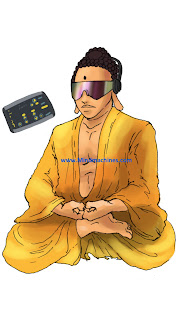Synchronizing Visual, Hearing and Touch Sensory Input: Light,
Sound and Tactile Stimulation with Motion
Motion
is so fundamental in the scheme of the universe, it is easy to overlook just
how essential it is to the human developmental process. In utero, the
developing fetus is in motion and suspended in a totally fluid medium. The
first parts of the nervous system to develop involve tactile and the
gravitational relationship mechanisms. For eons, mothers have instinctively
used motion by rocking their infants for calming and comfort.
Tactile stimulation uses
physical vibrations for physical entrainment.
When tactile stimulation is incorporated into the light and sound brainwave
frequency entrainment process, not only are our emotional and mental states involved,
but our physical state as well. Stimulating
our senses of vision and hearing, light and sound is much like a "from the
neck up" experience. Our emotional and mental states are of primary focus.
By adding motion and synchronizing tactile stimulation to light and sound
stimulation takes the "from the neck up" experience and elevates it
to a "complete mind and body" experience.
Many of us are unaware of how
our emotional and mental states can effect how we feel physically. Yet stress
and anxiety can manifest themselves in physical forms. Illness is a prime
example. Researchers and doctors believe 70-90% of illnesses owe their root
cause to stress. Incorporating motion and tactile stimulation with light and sound enables participants to
feel, as well as be mindful of, the sensations experienced during light and
sound brainwave entrainment sessions.
My first experience using
motion with tactile stimulation in conjunction with light and sound was in
1994. The vibroacoustic motion bed was
built by Larry Schulz of Integrative Motion Systems. An amplifier was used to
connect the light and sound machine (KasinaMind Media System by Mindplace) and the two transducers of the tactile
motion bed for complete light, sound and tactile synchronization. The bed has
360 degree orbital motion capability with 6 degree pitch (much like being on a
ship at sea). I began to explore what frequencies appeared to offer the most
benefits, in terms of tactile stimulation. The results suggest that dual
binaural beats in the 7 Hz to 14 Hz range were the most enjoyable and
effective.
You do not need to invest an
enormous amount of money to add tactile stimulation to your light and sound
experience. There are a variety of sound cushions available for around one
hundred dollars and they are fully compatible with light and sound
instrumentation. Do not be misled by vibrating mats. Make sure you purchase
sound cushions that contain high quality transducers (bass "shakers"
or speakers). Have two cushions, one for your back and one for your upper leg
area. Applying the two cushion/two transducer stimulation will enable the dual
binaural beats to gently guide your body into the same targeted state that your
mind experiences.
Combining light, sound and
tactile stimulation has become the ultimate experience in personal inner
exploration. It is a very dynamic method for enhancing the general wellbeing
for anyone fortunate enough to experience such a session.




No comments:
Post a Comment